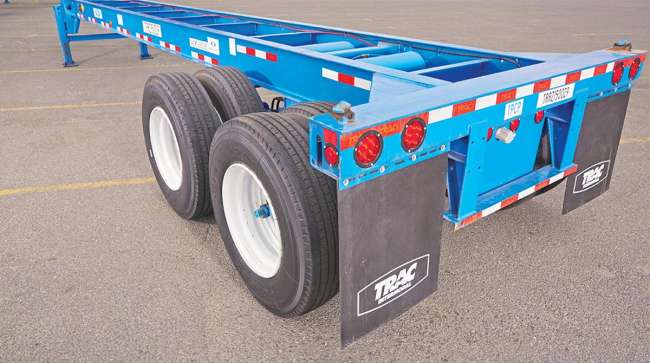Staff Reporter
Intermodal Chassis Manufacturers Pull Back on Output

[Stay on top of transportation news: Get TTNews in your inbox.]
Intermodal chassis manufacturers are scaling back production as a result of weak demand as well as a supply overhang, company executives said.
Chassis builder CIE Manufacturing has trimmed production based on market conditions, said VP of Sales and Marketing Ben Evans. The company operates U.S. production facilities in South Gate, Calif. and Emporia, Va. It is owned by China International Marine Containers.
“The market is extremely soft,” he said. “Demand is down across the board.” Evans noted this was true for both carriers and leasing companies.

Constantinides
Hyundai Translead Director of Intermodal Savvas Constantinides said 2024 has not been a good year in terms of production or utilization. He noted that leasing companies are using just 50% of their capacity, making equipment purchases more unlikely. “Unless something changes with the freight market, then there’s not going to be a great deal of demand for production,” he said.
ACT Research confirmed to Transport Topics that it is reducing its 2024 chassis production forecast, but declined to provide specifics.
“Whether it is chassis or containers, there is a lot of supply,” NFI Industries SVP Mark McKendry said. NFI ranks No. 16 on the Transport Topics Top 100 list of the largest for-hire carriers in North America, and No. 7 on the Intermodal/Drayage sector list.
Pratt Intermodal Chassis COO Kent Musick said demand for standard 40-foot gooseneck chassis is particularly slow. “We have seen a little bit of activity, but it is not setting the world on fire. It is not the heyday of 2021-22,” he said.
When the pandemic hit, U.S. intermodal chassis production doubled to more than 60,000 units. However, as Constantinides noted: “It was an anomaly. Anomalies need to be corrected.”
On the demand side, intermodal volumes fell for nine consecutive quarters into the third quarter of 2023, ACT analysts Kenny Vieth and Jennifer McNealy said in a joint email. They noted this decline pushed intermodal loads to levels not seen since 2013 — with the exception of the immediate pandemic period. However, even as intermodal volumes fell, intermodal chassis shipments by manufacturers rose to a record 61,800 units in 2022 and totaled 54,600 units in 2023. They stressed this supply-demand disconnect between chassis and loads grew over the course of 2022 and 2023.
The imbalance coming into 2024 led to the decline in chassis demand seen this year, the ACT analysts said.
Check out Transport Topics' updated Top 100 list of the largest logistics companies in North America, and explore how the industry's top players have adapted to a tough freight market and are preparing for the future. Tune in above or by going to RoadSigns.ttnews.com.
That said, executives are seeing pockets of niche upside. Stoughton Trailers is seeing more early quote interest in 53-foot rail intermodal chassis, VP of Intermodal Sales Patrick Gunn said. And PIC’s Musick said demand for 53-foot chassis is ticking up because of freight volumes moving inland over larger distances as opposed to the typical 150 miles seen for traditional hub-and-spoke activity.
Generally though, lingering economic malaise and uncertainty over the presidential election have buyers keeping their powder dry, Evans said. “We’re still in this dip for sure,” he said. “Not many people of size are interested in buying. We’re still in a wait-and-see mode at the moment.”
And that could continue, said Constantinides. “If leasing companies decide by October they are not going to make purchases, then 2025 is going to be a rough year,” he said.
One major chassis pool operator agrees. “Until we see new activity, I don’t see us acquiring new assets,” Trac Intermodal COO Val Noel said. Pools lease chassis to carriers. Trac is waiting to see what happens in the second half of the year, Noel said. Mostly, Trac is upgrading or refurbishing its rolling stock, he said.
The excess of capacity is hurting major carriers in the sector, multiple sources said.
Want more news? Listen to today's daily briefing above or go here for more info
“We have the resources and capacity to handle significantly more volume than what we are currently handling, to the tune of at least 20%,” J.B. Hunt Intermodal President Darren Field said during the company’s first-quarter 2024 earnings call. J.B. Hunt Intermodal ranks No. 1 on the Intermodal/Drayage sector list. “Overall, demand for our intermodal service was weaker than our expectations,” he added.
Plus, soft freight volume is keeping pressure on rates, NFI’s McKendry said. He noted that these rate pressures stretch back to the second quarter of 2022, but hit a floor in Q1 of this year. “It is a bloodbath on the fleet side,” he said, but noted that there has been a slight rebound since the Q1 trough.
“We have been surprised by how much competition we are seeing in bids,” Field added.



